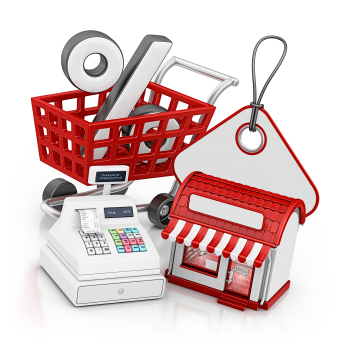Trying to sell your product to large retailers like Walmart, Best Buy, or Home Depot? Many thousands of businesses every year dream of getting their products into retailers like these. However, only a handful of vendors will make the cut. Why do some companies make it on the retailer’s shelves while many others don’t?
Here are some reasons why a particular company might be rejected by the retailer.
- The company or the products didn’t have a track record of sales (Buyers hate being a guinea pig for an untested product)
- The company did a poor job with their sales presentation to the buyer (Buyers can’t stand when a vendor does not prepare and wastes the time of the buyer)
- The product’s packaging was ineffective in communicating what the product offered to the consumer (The product’s packaging is your “best sales-person”. Not having a professional design your packaging guarantees failure before the product can get on a retailer’s shelf)
- The retailer’s cost or the suggested retail pricing was not correct (Companies either over-estimate or underestimate how much a retailer will pay for their product as well as what the end-consumer will pay for their product)
So, let’s get started on how to get your product to large retailers while avoiding the above situations.
Preparing Your Product for Retail Shelves
When preparing your product for placement on retail shelves, it’s essential to ensure that it meets industry standards and compliance. Large retailers have stringent quality and safety requirements that you must adhere to. Make sure your product:
- Complies with industry regulations and standards relevant to your product category. This may involve product testing, certification, and compliance with safety and quality standards.
- Has packaging and labeling that are not only aesthetically appealing but also informative and compliant. Clearly communicate essential product information, including ingredients, usage instructions, and safety warnings.
- Is competitively priced. Research the pricing strategies of your competitors and consider your production costs when setting your retail price. Be prepared to negotiate pricing with large retailers to reach a mutually beneficial agreement.
Building a Strong Product Pitch
Crafting a compelling product pitch is crucial when approaching large retailers. Your pitch should:
- Begin with a concise elevator pitch that encapsulates your product’s unique selling proposition (USP) in a few sentences. Highlight what sets your product apart from competitors.
- Tailor your pitch to align with the retailer’s brand and target audience. Show how your product complements their existing product range and meets the needs of their customer base.
- Provide evidence of market demand. Share market research data, customer testimonials, or sales figures that demonstrate the potential for your product’s success on their shelves.
Approaching Large Retailers
Cold calling and networking are valuable methods for getting your foot in the door with large retailers. Consider these strategies.
- Research key decision-makers and buyers within the target retail companies. Personalize your outreach to show that you’ve done your homework and are genuinely interested in their business.
- Attend industry events, trade shows, and conferences to network with retail professionals. Building relationships in person can open doors to opportunities you might not find elsewhere.
- Leverage existing connections. If you have contacts in the industry, ask for introductions or advice. Word-of-mouth referrals can be powerful.
Pitching Your Product to Large Retailers
Your product presentation to retail buyers should be professional and persuasive. Here’s how you can ace it!
- Develop a visually appealing and informative product presentation. Use visuals, product samples, and data to illustrate the benefits of your product.
- Address buyer concerns and objections proactively. Be ready to answer questions about pricing, product availability, and marketing support.
- Follow up after your initial pitch to nurture the relationship. Send thank-you notes and updates on your product’s performance in the market to keep buyers engaged.
Navigating Retailer Expectations and Requirements
Meeting retailer expectations involves more than just delivering your products. It also includes the following factors.
- Fulfillment and inventory management: Make sure to meet the retailer’s demands for timely delivery, consistent inventory, and order accuracy. Consider using inventory management software to streamline these processes.
- Negotiating payment terms and contracts: Payment terms can vary among retailers. Understand the terms and conditions of your agreements, including payment schedules, returns policies, and penalties for non-compliance.
- Delivery and quality assurance standards: Large retailers often have specific packaging and labeling requirements. Ensure that your products meet these standards to avoid disruptions in the supply chain.
Compliance and Regulations
Navigating compliance and regulations can be complex, but it’s essential to
- Comply with retailer-specific guidelines: Different retailers may have unique requirements for packaging, labeling, and product presentation. Familiarize yourself with each retailer’s guidelines to ensure compliance.
- Handle recalls and product safety issues: Develop a robust product recall plan and communicate it with your retail partners. Being transparent and accountable in the event of safety issues can help maintain trust.
- Maintain transparency and accountability: Large retailers value transparency in their relationships with suppliers. Keep accurate records of all transactions, and be proactive in addressing any issues that may arise.
Useful Tips to Get You Started
If your end goal is to sell to Wal-Mart, Best Buy, Home Depot or any other large retailer, the steps below can help.
- Are you ready for retail? Before you knock on the door of Wal-Mart, you need to ask yourself, “Am I ready yet to sell to retail, especially a large multi-billion dollar retailer?” Many clients that we work with are not ready yet to contact a retail buyer. From determining payment terms to how the product will ship to the retailer’s warehouses, many companies don’t have all the basic questions that a retail buyer will ask them figured out. Planning ahead and doing your homework on what questions a retail buyer may ask will put you ahead of the other companies vying for that spot on the retailer’s shelf.
- Determine the correct cost/pricing strategy: Before you approach Best Buy, you need to make sure you have factored in all the costs (i.e. manufacturing, packaging, marketing, distribution, sales commissions, etc…) of the product. We have seen companies trying to sell Best Buy and come to realize that they are not making any money. Why be in business if you can’t make a profit? The larger the retailer, expect less profit to make off them. However, because of the potential sales volume from Best Buy, it’s a wash. With smaller retailers, you can charge a higher cost to offset your smaller profits from large retailers like Best Buy.
- Making contact with the retail buyer: As a former retail buyer, I would get hundreds of phone calls or emails from prospective suppliers. Many of them did a very bad job in trying to land a sales appointment with me. If you want to get a retail buyer at Home Depot interested in your product and offer you an appointment to meet with him or her, here are some tips:
- Exhibit at industry trade shows. If you were selling Apple iPad accessories, as a retail buyer, I would expect to see you exhibit at the Consumer Electronics Show in Las Vegas in early January. While these shows cost money, you have a great chance of setting up appointments with retail buyers.
- Get mentioned trade publications. Retail buyers subscribe to various magazines in his/her trade. Try to get featured in one of those trade publications. A favorable article on your company’s product may catch the retail buyer’s eye.
- If you are “one-item” vendor, you may have better luck selling into Home Depot by selling to a distributor. A distributor sells many different vendors’ products into a retailer such as Home Depot. By using a distributor, Home Depot has fewer vendors to manage on a day-to-day basis
- Hire a manufacturer rep. If your sales skills are not sharp enough to go against some of the toughest buyers in the world, you may be better off in hiring a manufacturer rep. A manufacturer rep works on commission and may already have a relationship with the retail buyer at Home Depot. However, they are not employees of your company and you cannot tell what to do.
- If you can’t hire a manufacturer rep, try to get a recommendation or referral from a supplier already doing business with Home Depot. Cold-calling retail buyers can be stressful. However, when you call the retail buyer and mention that another supplier that you both mutually know told you to call the retail buyer, you probably will get a few more minutes to get the retail buyer’s attention.
4. AFT “Always Follow Through”: You can’t believe how many vendor meetings I have sat through where action items that the vendor promised to follow through on but never did. Do you know what happened? I didn’t buy from those particular companies. If they can’t deliver on their promises, how do I know they will be by my side when I really need them? Always follow through on your promises made to the retail buyer
Conclusion
By incorporating these strategies, insights, and expert advice into your approach, you can tackle the challenges of selling products to large retailers. Persistence, preparation, and building strong relationships are key to achieving success in this competitive space. Remember that selling to large retailers is a dynamic process that requires ongoing effort and adaptability.
If you’re looking to sell to Wal-Mart, Best Buy, Home Depot or any other retailer, remember to take your time and do your homework. Rushing to sell to a large retailer will cost you time, effort, and of course money down the road! To learn more about how to sell to large and small retailers, visit https://retailbound.com.



